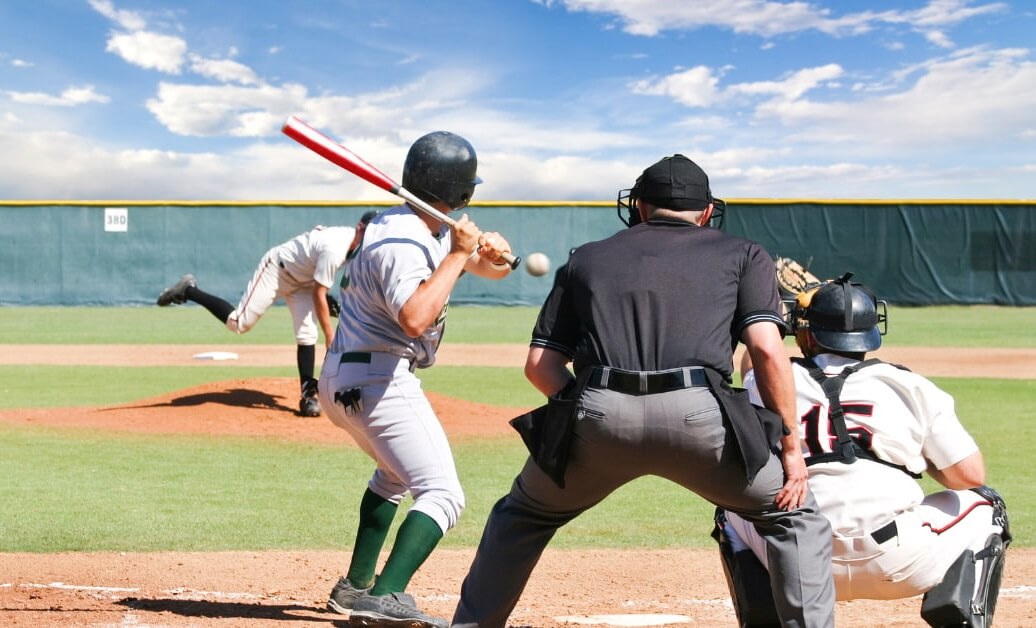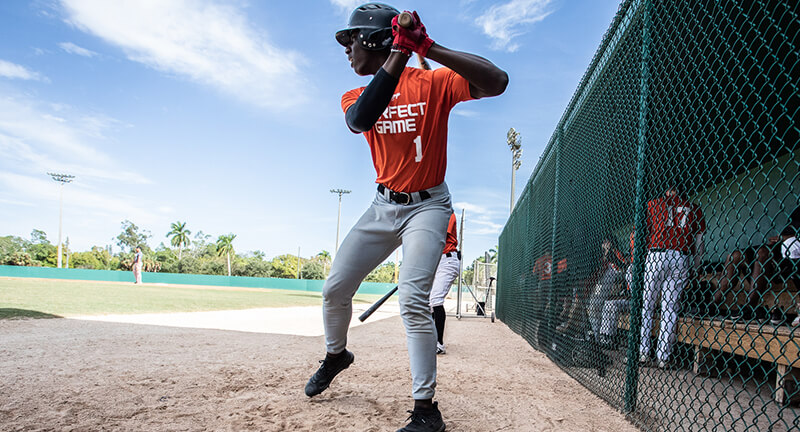In the realm of baseball, the ability to deliver a powerful hit is often the defining factor between a good player and a great one. Whether you’re a seasoned player looking to enhance your hitting prowess or a beginner eager to step up to the plate, this guide will provide you with valuable insights and techniques to become a better hitter in the world of baseball.
Proper Stance

A proper batting stance is essential for success at the plate. The stance provides balance, comfort, and allows the hitter to efficiently transfer weight and power.
There are several key elements to an effective stance:
-
Feet positioning – Feet should be shoulder width apart, with the front foot slightly ahead of the back foot pointed towards the pitcher. This athletic position provides stability and balance. The width provides a solid base to drive the swing.
-
Knee bend – Knees should have a slight bend, enough to feel athletic but not so much as to feel off-balance. This flex allows for optimal weight transfer during the swing.
-
Weight distribution – Weight should be balanced between both feet at the start. As the swing progresses, weight shifts to the back foot then transfers through the hips to the front foot. Even weight to start allows for fluid transfer.
-
Bat positioning – Hands should start extended with the bat at a 45-60 degree angle. This prepares the swing path and allows the hands to load back. Elbows can be up or tucked based on preference.
Getting into a comfortable, balanced, and athletic batting stance sets up the body for an efficient, powerful swing. It’s an essential foundation before addressing other hitting mechanics.
Grip

A proper grip is essential for generating bat speed and controlling the barrel of the bat. Most coaches recommend gripping the bat with your fingers, not the palms of your hands. The fingers provide more dexterity and bat control compared to the palms.
Specifically, your fingers should grip around the handle with the bat resting on top of your knuckles in your hands. Gripping too tight with the lower palm squeezing the handle can restrict wrist flexibility and bat control. Keep a firm but relaxed grip, like you are holding a tube of toothpaste. Allow your top hand to grip slightly harder than the bottom hand.
For more finger flexibility, try this grip strengthening exercise. The key is avoiding squeezing so tight that it locks up your wrists. Keep wrists loose and hands soft so you can generate whip through contact. Proper hand and wrist positioning sets the foundation for your swing path, bat speed, and swing mechanics.
Balance
Good balance is essential for successful hitting. If your balance is off, it can affect your head movement and limit your swing power. The key aspects of balance are head stillness, minimal upper body movement, and weight transfer.
To maintain balance and head stillness, you need a wide and sturdy base with your feet just outside shoulder width apart. Your knees should have a slight bend and your weight balanced evenly on the balls of your feet. As the pitch comes in, focus on keeping your head still and centered above your base. Any excess head movement can throw off your vision and timing.
You also want minimal extraneous upper body movement. As you start your swing, keep your shoulders and hips directed at the pitcher as long as possible. Avoid dipping your back shoulder or opening up too early. This allows you to direct all your energy and power directly into the swing.
Proper weight transfer is also key for balance. As you stride, your weight should shift to your back leg, keeping the head centered between your feet. Then as you swing, drive off your back leg, transferring your weight forward for maximum power. Staying balanced, centered, and smooth with your weight shift allows you to be quick to the ball while generating bat speed and power.
Swing Plane

The swing plane refers to the path the bat takes through the hitting zone. Having an optimal swing plane is important for generating bat speed and power.
Three main components determine the swing plane:
-
Level swing: The bat should stay on the same plane and not get steep or uptilted. Keeping a level swing allows the hitter to stay inside the ball and generate backspin and carry.
-
Swing trajectory: The trajectory of the swing determines the launch angle. An upward trajectory between 10-30 degrees is ideal for a line drive or fly ball. Too flat of a swing leads to groundballs.
-
Launch angle: The angle the ball comes off the bat determines the type of contact. A launch angle between 25-35 degrees optimizes distance and power. Anything below 10 degrees leads to weak groundballs.
The swing plane sets up the path for solid contact. Focusing on keeping the barrel in the hitting zone longer through a level swing plane with an upward trajectory will optimize launch angle and exit velocity.
Swing Timing
Timing is crucial for being a successful hitter in baseball. You want to avoid swinging too early or too late when the pitch is delivered. Proper timing involves identifying pitches and knowing when to start your swing so you can make solid contact with the ball.
As a pitch is being delivered, you need to pick up cues like the pitch grip, arm motion, and release point to identify what type of pitch it is. This allows you to anticipate how fast the ball will reach you. Fastballs get to the plate quicker than off-speed pitches like curveballs or changeups.
Once you determine the pitch type, you can judge when to start your swing to time it perfectly. Initiate your swing once the ball has traveled a certain distance to the plate based on how quickly you expect it to arrive. If you start too early, you’ll end up swinging underneath or fouling off pitches. If you start too late after the ball is released, your bat will lag behind the pitch and you’ll make weak contact. Proper timing takes practice, but being able to identify pitches and control your swing will allow you to consistently barrel up the baseball.
Plate Coverage

Plate coverage refers to a hitter’s ability to make contact with pitches across the entire strike zone. Expanding your plate coverage as a hitter is crucial for improving your batting average and overall effectiveness at the plate. There are two main areas to focus on for better plate coverage:
Reaching Outside Pitches
-
Work on extending your arms and getting full extension on pitches on the outer half of the plate. Concentrate on keeping your hands inside the ball and driving it to the opposite field.
-
Be selective and lay off pitches too far outside to avoid chasing and making weak contact. Focus on your strengths and look for pitches to drive in your power zone.
-
Use batting practice to hone your mechanics and get comfortable reaching outside pitches. Have coaches mix up locations to improve reactions.
Protecting the Inner Half
-
Keep your hands tight to your body and avoid opening up too quickly to better cover inside pitches.
-
Maintain balance and keep your head still on inner half strikes to see the ball better. Don’t overcommit.
-
Use soft toss drills and tee work to polish keeping your hands inside the ball on inner third pitches. Develop quick, compact swings on inside offerings.
Being able to cover the entire plate as a hitter allows you to attack a wider variety of pitches and keep the pitcher honest. Work on reaching outside strikes while also protecting the inner half for improved plate coverage and more production at the dish.
Power Transfer
To generate power and bat speed as a hitter, you need to use your legs and core to transfer energy to your swing. Proper power transfer starts with rotating your hips and shifting your weight to your back leg during the stride.
As the pitcher begins his motion, turn your hips so your back hip points towards the pitcher. This coil loads your back hip and engages your legs and core. Shift 60-70% of your weight to your back leg, keeping your front heel off the ground.
When striding, drive off your back leg and rotate your hips open explosively towards the ball. Time your hip rotation to pull the bat through the hitting zone. Let your back hip pull your hands through contact.
Using your legs and hips to initiate power, instead of just your arms, translates to better bat speed and more drive on contact. Your swing gains tremendous power when your legs, hips and core work in sequence to transfer energy up the kinetic chain.
Swing Mechanics

A proper swing mechanics is crucial for making consistent contact and hitting for power. Focus on keeping minimal upper body movement, using a rotational swing, and proper wrist action.
Minimal upper body movement allows you to keep your head and eyes still, tracking the ball into the zone for solid contact. Don’t pull your head off the ball or open up the front shoulder early. Keeping the upper body quiet allows force to be directed from the legs and hips into the swing.
Use your hips and legs to power a rotational swing. Generate torque by keeping your back elbow tucked in and turning your hips and torso fully. Pull the bat through the zone on the same plane rather than lifting it. Stay closed and use your back hip as an anchor.
Proper wrist action flicks the bat head through the zone at the last moment for increased bat speed. Keep the wrists firm at contact to avoid rolling over top of balls. Extend through the ball with loose wrists after contact.
Mental Approach
A hitter’s mental game is just as important as their physical skills and mechanics. Having the proper mental approach can help hitters stay focused, confident, and successful at the plate.
Here are some key elements of the mental side of hitting:
-
Focus on process over results – Don’t worry about the outcome of each at-bat. Instead, focus on your mental cues, pre-pitch routine, balance, and swing mechanics. Staying focused on executing the process will lead to better results over time.
-
Remain calm and confident – Confidence comes from preparation and trusting your abilities. Take deep breaths to remain relaxed, block out negative thoughts, and visualize success. Your confidence will carry over into positive performance.
-
Hit with a plan – Mentally approach each at-bat with a plan of attack based on the pitcher, situation, and your strengths. Decide if you want to drive certain pitches or work the count. Stick to your plan and don’t let the pitcher knock you off balance. Execute the plan with commitment.
Keeping a strong mental approach with these keys will help hitters maximize their success and consistency at the plate over a season.
Practice & Repetition

Consistent practice and repetition is key to improving as a hitter in baseball.
Here are some key ways to get your practice swings in:
-
Take regular batting practice. Work on hitting balls from both a coach and a pitching machine to get comfortable swinging at various speeds and locations. Batting practice allows you to groove your swing mechanics and work on hitting to all fields.
-
Use a batting tee for repetitive swing practice. The tee lets you lock in the optimal swing plane and path without worrying about pitch location. Tee work builds muscle memory so your swing stays consistent in games.
-
Identify and work on your weaknesses. If you struggle hitting outside pitches, take extra swings aimed at going the other way. Focus practice on problem areas so they become strengths.
The key is making your practice purposeful. Analyze your swing, find flaws, and drill the right things to engrain solid mechanics. With enough quality reps, your new swing thoughts will become natural in the batter’s box.
FAQs
How can I increase my bat speed?
A: Work on strengthening your core and practicing quick, controlled swings. Additionally, use a lighter bat during practice sessions to build speed.
Is it essential to have a consistent pre-swing routine?
A: Yes, a consistent routine helps create a mental and physical readiness for each at-bat. It can include visualizing success, adjusting your grip, or taking a practice swing.
Can mental preparation impact hitting performance?
A: Absolutely. A positive and focused mindset can enhance your hitting performance. Visualization, confidence-building, and staying calm under pressure are crucial mental aspects.
Conclusion
Becoming a better hitter in baseball is a journey that combines technique, practice, and a keen understanding of the game.








